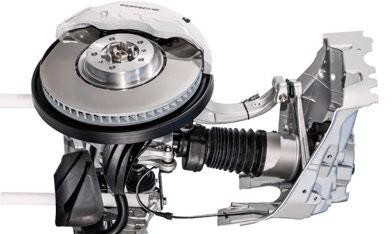Stopping power is the theme for this month as our mechanical engineer addresses your brake-related questions.


Stopping power is the theme for this month as our mechanical engineer addresses your brake-related questions.
When do I change my car’s brake pads? What should I use as a measure of wear – months, years or mileage? How can I tell if they need changing?
The life of a brake pad is determined primarily by how hard it is used. The age of a car does not make a difference to how fast it wears out.
If your driving style is generally fast acceleration, which demands hard and frequent braking, then the brake pads will wear out faster.
A gentler driving style will of course prolong the life of the pads.
Some drivers tend to brake each time the brake lights of the car in front light up. You can minimise braking by keeping your distance and modulating your speed.
High speeds demand higher braking forces and, logically, mean greater brake wear. Generally speaking, under normal driving conditions, most front brake pads will last between 40,000km and 60,000km.
Rear brake pads (or linings, in the case of drum brakes) last even longer as front brakes account for up to 75 percent of the braking force.
The brake pads in hybrid and electric cars can last twice as long because these vehicles use electric load to decelerate the vehicle for power regeneration.
Some cars have a built-in brake pad warning signal. While this is not a “danger” sign, it is advisable to renew brake pads at least within the next 2000km.
It is not diffcult to inspect the remaining brake pad thickness by yourself, but you need to know where to look.
As brakes are a critical safety component in a car, always replace them with the best quality parts. If you are unsure, get genuine brake pads or linings from your authorised vehicle distributor.

Why do carmakers use different types of materials for brake discs? I have heard of carbon-ceramic discs and Porsche has something called a surface-coated disc.
Most brake discs are made of cast iron. This material has good friction properties and, because it has been developed consistently over the decades, is the cheapest.
Today, carbon-ceramic brake discs are a standard feature on Formula 1 cars and most other race-prepared cars. Besides being almost 50 percent lighter than iron discs, carbon-ceramic discs have a huge advantage when it comes to wear resistance, stability and consistency.
On a few high-performance road cars, carbon-ceramic brake discs can be specified, but they come at a price. Hence such an option is usually available only on high-end performance cars.
Besides the prohibitive cost, these brakes also perform their best at high temperatures, making them less than suitable for normal road use.
Porsche’s new surface-coated disc, also known as the Porsche Surface Coated Brake (PSCB), is made from conventional cast iron, but goes through an additional process during manufacturing.
A coating of tungsten carbide is applied throughout the surface that makes contact with the brake pads. In terms of cost and performance, the PSCB sits midway between the normal cast-iron disc and the carbon-ceramic type.
The most interesting aspect of the PSCB is its permanent mirror-like surface once the disc has been run-in.
AS BRAKES ARE A CRITICAL SAFETY COMPONENT IN A CAR, ALWAYS REPLACE THEM WITH THE BEST QUALITY PARTS.

As long as there’s no brake dust, Porsche’s Surface Coated Brake will have a permanent, mirror-like finish.
My car is seven months old. After not driving it over a weekend, I had a problem on Monday morning. I shifted to D, but the car did not creep, as it usually does, when I released the brake pedal. After a few seconds, I pressed the accelerator pedal gently. Suddenly, there was a frightening “thud” just before the car started to move. I have noticed that there is also a mild squeak from the rear suspension the moment I sit in the car. While I am of above- average build, I cannot accept that the suspension is under stress because of my weight. Are these two problems related and are they serious?
The “thud” you heard is most likely from the parking brake. Often, especially with disc-brake systems, the pads tend to stick to the disc after a few days of being idle.
This also happens when the car is parked for a prolonged period in rainy weather. Some corrosion builds up on the disc, creating some resistance.
So, when you apply a little power, the pads break from the adhesion, resulting in the disconcerting “thud”.
All this is normal and in no way detrimental to the car’s braking system.
As for the “squeak”, try to do the same motion with the parking brake off, but gear lever in P.
You are likely not to hear any sound at all.
In many cars, the suspension design is such that small changes in the ride height – caused by someone getting in the car – require the rear wheels to move rearwards.
With the parking brake on, this means the wheel will rotate very slightly against the brakes, giving rise to the sound you hear.
MAIN PHOTO & ILLUSTRATION 123RF.COM























